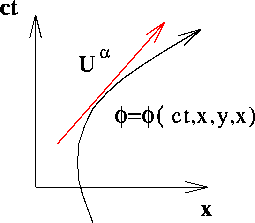For a scalar field ![]() and a world
line of some particle
and a world
line of some particle ![]() , we have
, we have
![]()

Figure 3.2: World line of particle with four- velocity ![]() .
.
If ![]() is the tangent to the curve [ the four- velocity of the
particle, see Figure 3.2 ] then:
is the tangent to the curve [ the four- velocity of the
particle, see Figure 3.2 ] then:
![]()
so
![]()
since ![]() [see section 2.2].
[see section 2.2].
This defines a one- form since
it maps ![]() into real numbers and represents the rate of change
of
into real numbers and represents the rate of change
of ![]() along a curve with tangent
along a curve with tangent ![]() .
.
![]()
In three dimensions one thinks of a gradient as a vector [ normal to surfaces
of constant ![]() ] but
] but ![]() is a one- form and specifies a
vector only if there is a metric.
is a one- form and specifies a
vector only if there is a metric.
Now how do the components of ![]() transform?
transform?
![]()
But we also have by the chain rule:
![]()
which means that
![]()
so
![]()
and since ![]() we have
we have
![]()
This is a useful result, that the basis one- form is just ![]() .
.